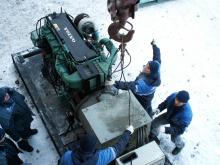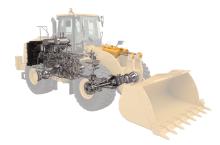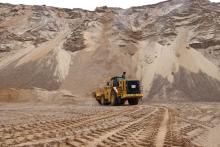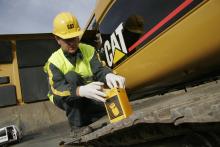
If it is true that a cat has nine lives, then one UK quarry's Cat wheeled loader has just regained a few following a complete refurbishment programme to rejuvenate the machine instead of replacing it.
The
The sand and gravel quarry opened in 1988 and with 18million tonnes of reserves still within the planning permission area, the quarry has at least another 20 years of operational life. The site produces around 750,000tonnes of material each year which is used in Hanson's own concrete business as well as sold into the local construction market where demand for sand is growing. With that in mind, Hanson is investing around £2.2million (€2.75million) in the site to improve production and the shutdown was to allow this upgrading work to be carried out.
"The shut down was planned to allow the sand production plant at the quarry to be upgraded and altered," explaind Barton quarry manager Damian McClean. "The main focus of the work was to install a new lignite removal facility that will help to improve the quality of the sand we produce.
"Other work scheduled included full automation of the batching and blending plants, which has freed up one operative for inspection work. The plant is operated at its maximum capacity constantly, so the regular inspection is important to avoid any breakdowns." While all this was underway, the site's 972G wheeled loader was taken to UK Cat dealer Finning's Cannock workshop to have its engine and transmission stripped, refurbished and repaired.
The machine was first delivered to Barton Quarry in 2002 and has put in more than 13,000 hours of loading sand and gravel hoppers and articulated dump trucks during its six day week use. According to McClean, the refurbishment of the machine was able to be planned to avoid major breakdown but coincide with the shut-down through regular servicing by
Having performed all of the regular 500 hour scheduled maintenance and conducted scheduled oil sampling at each service interval, as part of an agreed support package, Finning engineers led by product support consultant Noel Hancock, were able to identify the need for 'repair before failure' engine and transmission work to be carried out.
"When you are able to gather data from a piece of plant equipment over a long period of time, you are in a very strong position to identify the key performance indicators that can lead to equipment failure," explained Hancock. "For example with our analysis of oil samples taken from Barton Quarry's 972G we were able to confirm that although the engine and transmission were showing normal signs of wear for the age of the machine, no critical parts had been damaged, and therefore it would be the ideal time to carry out a before failure repair." According to Hancock, the importance of this process and information becomes clear when you look to analyse the cost of refurbishment. "It is not until you have been able to take the machine, engine and transmission apart that it is possible to truly understand what work is required. Through oil sampling however, you have a good indication that key parts are still intact and can be refurbished," he said.
This level of certainty was key in Hanson's decision to opt for refurbishment rather than investing in a new machine. No matter what work needed to be done to restore the wheeled loader to its former glory, the machine needed to be back on site and working within two weeks.
To ensure the project did not overrun, Finning's workshop team split the task of engine, transmission and associated machine refurbishment between four key personnel. "By dividing the task of engine and transmission rebuild between two people working side by side we were able to give each part of the project a dedicated focus and individual ownership," said Hancock.
Before any work took place the Cat 972G was washed off and pre-inspected for any other maintenance needs, identifying potential issues that could be fixed at the same time to avoid future downtime. Nonetheless, the machine was in good condition and no other additional work was discovered. "This combined with the historic data we had on the machine meant we were confident that the rebuild process would not throw up any surprises," said Hancock.
Having pre-ordered all of the required parts for the rebuild, the engine and transmission units were removed in one piece from the chassis by removing the cab and engine guards. The parts were then transported via overhead crane to the specialist component workshop bays at Cannock where the engine and transmission were split from one another.
Cat has guidelines for the refurbishment of each machine and following this the engine was completely stripped down with all parts checked for wear and inspected for damage using Cat's Service Information System, which provides all the specifications and guidelines needed to perform the engine refurbishment.
The engine was stripped over two days and it then took a further six days to replace and refurbish any worn parts and included the turbo chargers, bearings, gaskets and seals, injectors, pistons and liners.
The refurbishment of the Cat 972G's transmission unit also included a complete strip down, with particular attention paid to the transfer block, torque converter and transmission pump, all of which were completely overhauled. The bearings and gaskets were also replaced.
"Unlike the engine refurbishment we were presented by a small challenge with one of the transmission housings where a few cracks were found to be developing," said Hancock. "Fortunately this did not set back the project timing, as we were able to replace the housing with parts already available and in stock on-site." The work on the engine and transmission was finished within a day of each other and were linked back together before being placed back into the wheeled loader. While the work on the engine and transmission was underway, all the line seals, coolant hoses and fluids on the machine were also replaced.
The machine was delivered safely back to Barton Quarry before the end of the shutdown and ready for work. "The refurbishment option obviously worked extremely well with the unit repaired and back on site in just two weeks," said McClean. "From an operational perspective we are now able to benefit from a machine that has had potentially another 14,000 hours of life put back into the engine and transmission - effectively doubling its life for its current application, for a fraction of the cost of a new machine."









